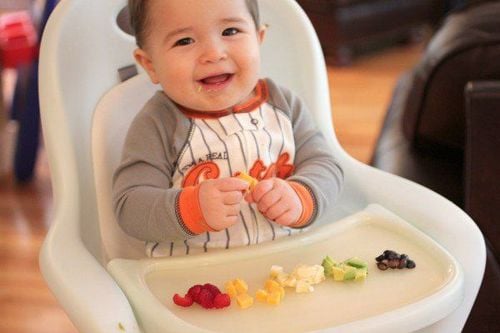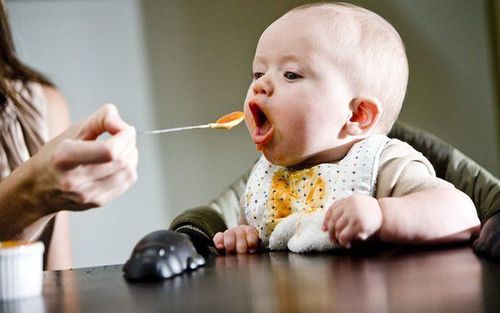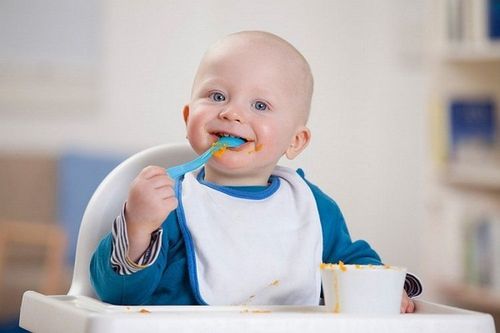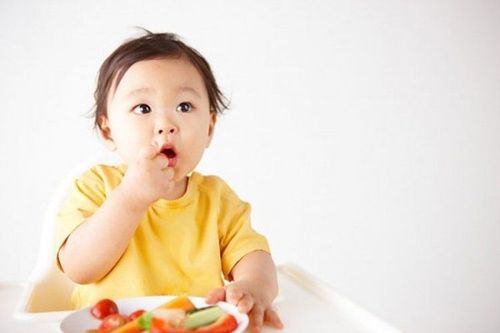This is an automatically translated article.
The article is professionally consulted by Specialist Doctor II Le Thanh Cam - Pediatrician - Pediatrics - Neonatology - Vinmec Danang International General HospitalAmong the methods of weaning for children, there are three commonly used methods: traditional weaning (pooping), Japanese weaning and self-directed weaning. Each method will have its own advantages and disadvantages. In this article, we will share with our readers the basics of self-directed weaning, also known as BLW weaning.
1. What is self-directed weaning?
Baby led weaning, also known as BLW weaning, is a method of weaning that allows babies to decide on food and how to eat. In this method, children are free to decide what foods they will eat first or later, like to eat or not like to eat, children eat quickly, or put food in their mouths in the way they want... This requires parents to respect their children's decisions and eating preferences so that children can freely express and explore as well as get used to eating in the most natural way.
When self-directed weaning, parents should eat with their baby at the same table, at the same time and with the same food as the baby because this will help stimulate the baby's desire to explore and enjoy food from the very beginning. first weaning.
2. Benefits of self-directed weaning
Letting your baby decide on food and how to eat according to the BLW weaning method will help children develop skills naturally, children can explore the world of food at their own pace. At the same time, it also makes it easier for mothers in the process of feeding and choosing food for their babies.

Thức ăn chọn cho trẻ nên đảm bảo đủ dinh dưỡng
Helps children practice ingenuity in approaching and handling food, increasing the ability to recognize and distinguish food through taste and smell. sense and sight. Help children visualize and understand the world just through playing with food. Joining meals with the family will help create closeness and intimacy between the baby and family members. On the other hand, children often have the characteristic of imitating the behaviors and habits of adults. Therefore, during meals, the behavior, handling or communication of everyone in the family can affect the baby. A healthy and authentic meal will help children learn many things. Letting children eat by themselves is also a way for children to practice their dexterity in coordinating the actions of their hands, mouth and eyes in performing the manipulation of taking food into their mouths.
3. Principles when implementing self-directed weaning
In order to properly feed children with BLW weaning, you need to have the following principles:
About food:
The dishes are chosen in accordance with the child's preferences but still have to ensure adequate nutrition. Choose foods according to the child's age to ensure that the baby's body can absorb the nutrients. It is possible to change the size and shape of food to make it easier for children to eat, such as cutting yarn or cutting into short sticks... Avoid giving children foods with a lot of salt, sugar, honey, ready-to-eat foods, fast foods. , poached eggs or cereal grains ... because the baby's digestive system is still weak and has not yet completed its functions, it will be difficult to absorb and eliminate these substances.

Cha mẹ nên cho trẻ ngồi trên ghế tập ăn
About how to eat:
Posture: the child can eat on the parent's lap, but it is best for the child to sit on a high chair. Train your baby to get used to the sitting posture right from the beginning, facing the table. Make sure you are the only one providing the food for the baby and not the one feeding the baby. Let children get used to and independent with eating. Choose the right feeding time, when the child is awake, not tired, not sleepy, not fussy. Do not rush the child to eat, do not speak or make gestures that distract him when handling food. Do not try to feed or force children to eat foods that they do not like, eat more than the amount of food they want.
4. Some problems may be encountered when giving self-directed weaning to children
In the BLW weaning method, children are respected for their taste and way of eating, so they often only eat foods that they like, which can lead to a risk of being deficient in some nutrients in their diet such as: iron... On the other hand, the child can be free to eat the way he wants so there is a possibility of choking or choking on the food.There is an observational study that has shown that the BMI of BLW-fed babies is significantly lower than that of fed babies. Therefore, when deciding to give children self-directed weaning, mothers often consider carefully the dishes provided to their children as well as how to educate and teach children about eating habits.
Weaning is one of the essential things that play an important role in both physical and intellectual development. Listen to the opinions of experts, be careful in choosing a suitable weaning diet for your child to ensure the complete health and development of the child.
The period of baby eating solid foods is an extremely important period to help children develop comprehensively. Children who do not eat properly are at risk of micro-mineral deficiencies, causing anorexia, growth retardation, malabsorption, etc. If they notice the above signs, parents should supplement their children with supportive products. The supplement contains lysine, essential micro-minerals and vitamins such as zinc, chromium, selenium, and B vitamins to help fully meet the nutritional needs of children. At the same time, these essential vitamins also support digestion, enhance nutrient absorption, help improve anorexia, and help children eat well.
Parents can learn more:
Signs of zinc deficiency in children
Micronutrient deficiency and failure to gain weight in children
Please regularly visit Vinmec.com website and update useful information to take care of your child. Take care of the baby and the whole family.














